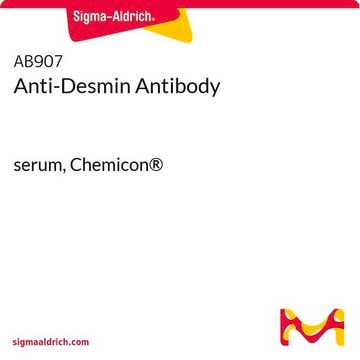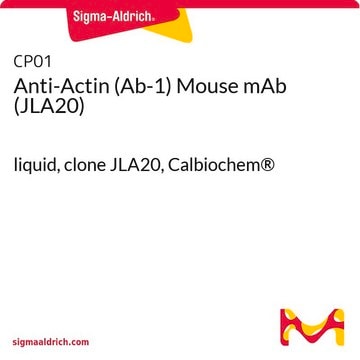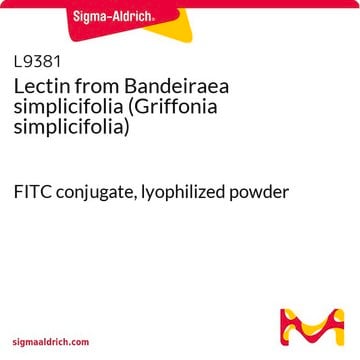113200
Anti-α-Actin Mouse mAb (1A4)
liquid, clone 1A4, Calbiochem®
Sign Into View Organizational & Contract Pricing
All Photos(1)
About This Item
UNSPSC Code:
12352203
NACRES:
NA.41
Recommended Products
biological source
mouse
Quality Level
antibody product type
primary antibodies
clone
1A4, monoclonal
form
liquid
contains
≤0.1% sodium azide as preservative
species reactivity
baboon, rabbit, human
manufacturer/tradename
Calbiochem®
storage condition
do not freeze
isotype
IgG2a
shipped in
wet ice
storage temp.
2-8°C
target post-translational modification
unmodified
Gene Information
human ... ACTA1(58)
General description
Mouse monoclonal antibody. Recognizes α-actin in smooth muscle cells.
Recognizes α-actin in smooth muscle cells of blood vessels and parenchymal tissue of the intestine, testis, and ovary. Does not recognize actin from fibroblasts (β- and γ-cytoplasmic), striated muscle (α-sarcomeric), or myocardium (α-myocardial).Antibody Target Gene Symbol: ACTA2 Target Synonym: 0610041G09RIK, a-SMA, AAT6, ACTSA, Actvs, ALPHA ACTIN VSM, ALPHA SMA, ALPHA SMOOTH MUSCLE ACTIN, ALPHA-ACTIN 2, FLJ45296, MGC127800, RGD: 621676, Similar to vascular alpha actin, Sm alpha actin, SMalphaA, SMOOTH MUSCLE ALPHA ACTIN Entrez Gene Name: actin, alpha 2, smooth muscle, aorta Hu Entrez ID: 59 (Related Antibodies: 113200) Rat Entrez ID: 81633
This Anti-α-Actin Mouse mAb (1A4) is validated for use in Frozen Sections, Immunoblotting, Paraffin Sections for the detection of α-Actin.
Immunogen
Human Smooth Muscle
a synthetic peptide corresponding to amino acids 1-10 of human smooth muscle α-actin.
Application
Frozen Sections (1:50-1:75)
Immunoblotting (see comments)
Paraffin Sections (1:50-1:75)
Immunoblotting (see comments)
Paraffin Sections (1:50-1:75)
Packaging
Please refer to vial label for lot-specific concentration.
Warning
Toxicity: Standard Handling (A)
Physical form
In 150 mM NaCl, 20 mM Tris-borate, BHC-6 carrier polysaccharides, pH 7.5.
Analysis Note
Negative Control
Fibroblasts, striated muscle, or myocardium
Fibroblasts, striated muscle, or myocardium
Positive Control
Smooth muscle cells of blood vessels and parenchymal tissue of intestine, testis, or ovary
Smooth muscle cells of blood vessels and parenchymal tissue of intestine, testis, or ovary
Other Notes
Does not recognize actin from fibroblasts (β- and γ-cytoplasmic), striated muscle (α-sarcomeric), or myocardium (α-myocardial).Prolonged fixation in buffered formalin destroys the epitope. The antibody is specific for the α-smooth muscle isoform of actin. This antibody is also reported to work for immunoblotting. Variables associated with assay conditions will dictate the proper working dilution.
Rannov-Jennsen, L., et al. 1990. Lab Invest.63, 532.
Skalli, O., et al. 1989. J. Histochem. Cytochem37, 315.
Skalli, O., et al. 1986. J. Cell. Biol. 103, 2787.
Skalli, O., et al. 1989. J. Histochem. Cytochem37, 315.
Skalli, O., et al. 1986. J. Cell. Biol. 103, 2787.
Legal Information
CALBIOCHEM is a registered trademark of Merck KGaA, Darmstadt, Germany
Not finding the right product?
Try our Product Selector Tool.
Storage Class Code
12 - Non Combustible Liquids
WGK
WGK 2
Flash Point(F)
Not applicable
Flash Point(C)
Not applicable
Certificates of Analysis (COA)
Search for Certificates of Analysis (COA) by entering the products Lot/Batch Number. Lot and Batch Numbers can be found on a product’s label following the words ‘Lot’ or ‘Batch’.
Already Own This Product?
Find documentation for the products that you have recently purchased in the Document Library.
Aya Nomura-Kitabayashi et al.
Methods in molecular biology (Clifton, N.J.), 1816, 253-268 (2018-07-11)
We introduced the vascular remodeling mouse system induced by the wire injury to investigate the molecular and cellular mechanisms of cardiovascular diseases. Using these models, we focus on the adventitial cell population in the outermost layer of the adult vasculature
Tobias Reicherzer et al.
American journal of physiology. Lung cellular and molecular physiology, 315(1), L87-L101 (2018-04-13)
Mesenchymal stromal cells (MSCs) are released into the airways of preterm infants following lung injury. These cells display a proinflammatory phenotype and are associated with development of severe bronchopulmonary dysplasia (BPD). We aimed to characterize the functional properties of MSCs
Tayyab Shahzad et al.
Cell death & disease, 13(7), 614-614 (2022-07-16)
The hyperoxia-induced pro-inflammatory response and tissue damage constitute pivotal steps leading to bronchopulmonary dysplasia (BPD) in the immature lung. The pro-inflammatory cytokines are considered attractive candidates for a directed intervention but the complex interplay between inflammatory and developmental signaling pathways
Tomohiro Ohtsuki et al.
Journal of the American Heart Association, 8(23), e013716-e013716 (2019-11-23)
Background Circulating proteins are exposed to vascular endothelial layer and influence their functions. Among them, adipsin is a member of the trypsin family of peptidases and is mainly secreted from adipocytes, monocytes, and macrophages, catalyzing the rate-limiting step of the
Xiaoliang Yan et al.
Experimental and therapeutic medicine, 23(4), 292-292 (2022-03-29)
The recently identified adipocytokine omentin was previously found to be expressed mainly in human omental and visceral adipose tissues. As such, reduced plasma concentrations of omentin were revealed to be associated with increased risks of cardiovascular diseases. Omentin has also
Our team of scientists has experience in all areas of research including Life Science, Material Science, Chemical Synthesis, Chromatography, Analytical and many others.
Contact Technical Service








